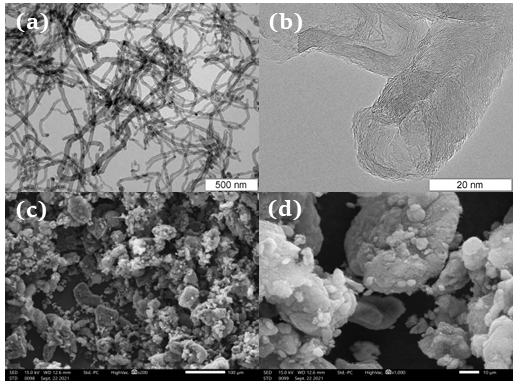
Solvent effect on the NO2 sensing properties of multi-walled carbon nanotubes
Abstract
Keywords
Full Text:
PDFReferences
Li H-Y, Zhao S-N, Zang S-Q, Li J. Functional metal–organic frameworks as effective sensors of gases and volatile compounds. Chem Soc Rev. 2020;49:6364–6401. doi:10.1039/C9CS00778D
McGinn CK, Lamport ZA, Kymissis I. Review of gravimetric sensing of volatile organic compounds. ACS Sensors. 2020;5:1514–1534. doi:10.1021/acssensors.0c00333
Freddi S, Emelianov AV, Bobrinetskiy II, Drera G, Pagliara S, Kopylova DS, Chiesa M, Santini G, Mores N, Moscato U, et al. Development of a sensing array for human breath analysis based on swcnt layers functionalized with semiconductor organic molecules. Adv Health Mater. 2020;9:2000377. doi:10.1002/adhm.202000377
Lin T, Lv X, Hu Z, Xu A, Feng C. Semiconductor metal oxides as chemoresistive sensors for detecting volatile organic compounds. Sensors. 2019;19. doi:10.3390/s19020233
Peng G, Tisch U, Adams O, Hakim M, Shehada N, Broza YY, Billan S, Abdah-Bortnyak R, Kuten A, Haick H. Diagnosing lung cancer in exhaled breath using gold nanoparticles. Nat Nanotechnol. 2009;4:669–673. doi:10.1038/nnano.2009.235
Kumar V, Kim K-H, Kumar P, Jeon B-H, Kim J-C. Functional hybrid nanostructure materials: advanced strategies for sensing applications toward volatile organic compounds. Coord Chem Rev. 2017;342:80–105. doi:10.1016/j.ccr.2017.04.006
Lee J, Jung M, Barthwal S, Lee S, Lim S-H. MEMS gas preconcentrator filled with CNT foam for exhaled VOC Gas detection. Biochip J. 2014;9. doi:10.1007/s13206-014-9106-y
Bruderer T, Gaisl T, Gaugg MT, Nowak N, Streckenbach B, Müller S, Moeller A, Kohler M, Zenobi R. On-line analysis of exhaled breath. Chem Rev. 2019;119:10803–10828. doi:10.1021/acs.chemrev.9b00005
aZhou X, Xue Z, Chen X, Huang C, Bai W, Lu Z, Wang T. Nanomaterial-based gas sensors used for breath diagnosis. J Mater Chem B. 2020;8:3231–3248. doi:10.1039/C9TB02518A
Zhang L, Khan K, Zou J, Zhang H, Li Y. Recent advances in emerging 2d material-based gas sensors: potential in disease diagnosis. Adv Mater Interfaces. 2019;6:1901329. doi:10.1002/admi.201901329
Wang T, Qi D, Yang H, Liu Z, Wang M, Leow WR, Chen G, Yu J, He K, Cheng H, et al. Tactile chemomechanical transduction based on an elastic microstructured array to enhance the sensitivity of portable biosensors. Adv Mater. 2019;31:1803883. doi:10.1002/adma.201803883
Bannov AG, Jasek O, Manakhov A, Marik M, Necas D, Zajickova L. High-performance ammonia gas sensors based on plasma treated carbon nanostructures. IEEE Sens J. 2017;17:1964–1970. doi:10.1109/JSEN.2017.2656122
Wang M, Wei Y, Zou Q, Zhang W, Xu A, Li X. Tuning manganese (iii) species in manganese oxide octahedral molecular sieve by interaction with carbon nanofibers for enhanced pollutant degradation in the presence of peroxymonosulfate. J Colloid Interface Sci. 2019;536:271–280. doi:10.1016/j.jcis.2018.10.055
Bannov AG, Prášek J, Jašek O, Zajíčková L. Investigation of pristine graphite oxide as room-temperature chemiresistive ammonia gas sensing material. Sensors. 2017;17. doi:10.3390/s17020320
Ahmad Z, Naseem Manzoor S, Talib M, Islam SS, Mishra P. Self-standing MWCNTs based gas sensor for detection of environmental limit of CO2. Mater Sci Eng B. 2020;255:114528. doi:10.1016/j.mseb.2020.114528
Sharma S, Hussain S, Singh S, Islam SS. MWCNT-conducting polymer composite based ammonia gas sensors: a new approach for complete recovery process. Sensors Actuators B Chem. 2014;194:213–219. doi:10.1016/j.snb.2013.12.050
Ionescu R, Espinosa EH, Sotter E, Llobet E, Vilanova X, Correig X, Felten A, Bittencourt C, Lier G. Van Charlier J-C, et al. Oxygen functionalisation of MWNT and their use as gas sensitive thick-film layers. Sensors Actuators B Chem. 2006;113:36–46. doi:10.1016/j.snb.2005.02.020
Sabri FNAM, Zakaria MR, Akil HM. Dispersion and stability of multiwalled carbon nanotubes (MWCNTs) in different solvents. AIP Conf Proc. 2020;2267. doi:10.1063/5.0024711
Santiago EV, López MAC, Marcelino JEM, López SH. Dispersion of MWNT under different solvents and its effect on the electrical properties of cured-epoxidized linseed oil composites. Int J Compos Mater. 2018;8:10–17. doi:10.5923/j.cmaterials.20180801.02
Bokach NA, Bolotin DS, Boyarsky VP, Kinzhalov MA, Tolstoy PM, Chulkova TG. Reference Tables on the theoretical foundations of organic chemistry and organometallic chemistry of transition elements; 2020; ISBN 9785965105380.
Liu S, Wang Z, Zhang Y, Zhang C, Zhang T. High performance room temperature NO2 sensors based on reduced graphene oxide-multiwalled carbon nanotubes-tin oxide nanoparticles hybrids. Sensors Actuators B Chem. 2015;211:318–324, doi:10.1016/j.snb.2015.01.127
Li L, He S, Liu M, Zhang C, Chen W. Three-dimensional mesoporous graphene aerogel-supported SnO2 nanocrystals for high-performance NO2 gas sensing at low temperature. Anal Chem. 2015;87:1638–1645. doi:10.1021/ac503234e
Barthwal S, Singh B, Singh NB. ZnO-SWCNT nanocomposite as NO2 gas sensor. Mater Today Proc. 2018;5:15439–15444. doi:10.1016/j.matpr.2018.05.030
Lapekin NI, et al. Vliyanie davleniya pressovaniya na gazochuvstvitel'nye svojstva mnogostennyh uglerodnyh nanotrubok. NSTU: Novosibirsk; 2021;51–55. Russian.
DOI: https://doi.org/10.15826/chimtech.2022.9.3.11
Copyright (c) 2022 Nikita I. Lapekin, Tatyana V. Anufrieva, Arina V. Ukhina, Artem A. Shestakov, Alexander G. Bannov

This work is licensed under a Creative Commons Attribution 4.0 International License.
Chimica Techno Acta, 2014–2025
eISSN 2411-1414
Copyright Notice







